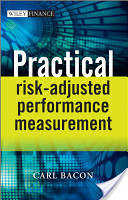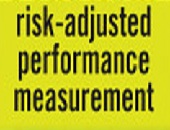The risk measures, both ex post and ex ante, that formed the hands-on component of the one-day workshop on risk-adjusted performance measurement at the CFA Society Toronto offices, are covered in greater detail by the book Practical Portfolio Performance Measurement & Attribution. The author (and workshop leader), Carl Bacon, gave the workshop participants a whirlwind tour on September 17, 2012. This continues a recap of the highlights begun in Part 1 of this posting.
Simple risk measures are “stand-alone” for a given portfolio (e.g., variability and Sharpe Ratio), or they are calculated in conjunction with another benchmark or portfolio (e.g., tracking error, information ratio). [Incidentally, when calculating the variability (more commonly known as the volatility), the Excel function STDEV gives the sample metric. It is STDEVP that should be used to determine the true population metric.] The annualized standard deviation is a “remarkably crude” measure, Bacon reminded the workshop participants, because it makes an assumption of independence from week to week or month to month.
From the Sharpe ratio, we moved to M^2 (M-squared). The Sharpe ratio is the gradient of the risk-return curve, and M^2 is the return adjusted for risk.
Tracking error is the standard deviation of excess return against a benchmark, Bacon reminded us. It can be calculated ex post or forecast ex ante, and Bacon urged all investors to ask how the tracking error of a fund is determined. The tracking error is a neat summary of the consistency of excess return.
 Bacon recommends the information ratio as a personal favourite. This is a ratio of the annualized excess return (against a benchmark) over the annualized tracking error. “A negative information ratio means you’ve underperformed. Any information ratio above zero is good. An information ratio above 0.75 is very good; above one, it’s exceptional,” he said. He did not care much for modified information ratios.
Bacon recommends the information ratio as a personal favourite. This is a ratio of the annualized excess return (against a benchmark) over the annualized tracking error. “A negative information ratio means you’ve underperformed. Any information ratio above zero is good. An information ratio above 0.75 is very good; above one, it’s exceptional,” he said. He did not care much for modified information ratios.
Bacon summarized regression statistics. The correlation is the ratio of systematic risk to portfolio risk; the coefficient of determination is the ratio of systematic variance to portfolio variance. In both cases, it is the systematic quantity, not the idiosyncratic quantities of interest.
Fama decomposition was the original risk-adjusted performance attribution, according to Bacon. Fama decomposed returns into systematic-risk-based and selectivity-based. Variations on this are the Fama-French Three Factor Model, the Carhart Four Factor Model, and the Graham and Harvey models.
The workshop returned to the more familiar territory of descriptive statistics including covariance with respect to benchmark, and the correlation coefficient. Whether or not benchmark data are available, the skewness, kurtosis, and Fisher’s kurtosis (a.k.a. excess kurtosis) can be determined for any set of returns.
The adjusted Sharpe ratio is an innovation that seeks to reward positive skewness, penalize negative skewness, and reward kurtosis less than 3.
The workshop made participants familiar with risk-adjusted performance measures both within and outside of the CFA Candidate Body of Knowledge. There were numerous other topics that Bacon touched on (e.g. the Bera-Jarque Test, the Hurst Index, and so forth). “Everything but the kitchen sink,” one participant said afterward.
Not only were concepts presented in a systematic context, they were encountered again when participants had to apply them in a spreadsheet for a sample portfolio. The hands-on component is invaluable for clarifying some of the finer details of the calculation. This was a highly enjoyable workshop and the take-away spreadsheets are no doubt already in use on some fund managers’ desktops. ª
Carl Bacon’s book, Practical Portfolio Performance Measurement & Attribution, 2nd edition can be found at its publisher’s page at: http://ca.wiley.com/WileyCDA/WileyTitle/productCd-0470059281.html
Ed. Note: Two months after the workshop, Carl Bacon’s latest book Practical Risk-Adjusted Performance Measurement (2012) was released, also by John Wiley & Sons.

